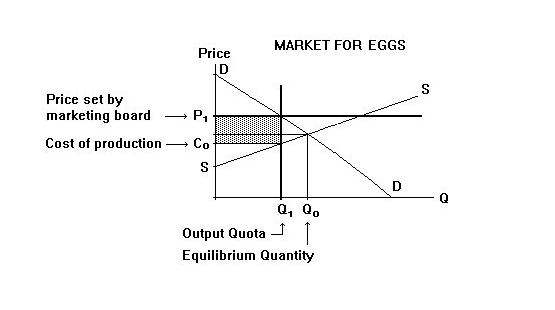
1. inevitably leave a surplus that the government has to absorb.
2. cause the supply curve of output to shift upward.
3. enable egg producers to sell every unit of their output at a price at or above its production cost.
4. do none of the above.
Choose the option that yields the correct answer.
Option 3 is the correct choice. The output controls limit the amounts of eggs that individual producers can sell, but leave them free to produce each unit of output as cheaply as they can. Unlike acreage controls, there are no restrictions on the inputs that can be used. As a result, costs will decline as producers move to the left along the supply curve (which gives the minimum cost of producing each level of output). If the supply curve happens to be horizontal, costs will remain constant as output declines. At the same time, as output declines producers will be able to charge consumers the higher-than-free-market price for eggs established by the marketing board.
This can be seen with reference to following Figure.

The demand curve for eggs is DD and the supply curve is SS. The Egg Marketing Board regulates the price at P1 and divides among producers, according to past output or other criteria, the quota Q1. Producers produce output Q1 at a cost equal to C0, making a profit (equal to revenue minus cost) of the shaded area. As we move to the left along the supply curve, the payments to labor and/or capital and/or land may fall. Any producer that is using inputs owned by himself may therefore gain somewhat less than indicated by the shaded area. These issues are discussed in detail in the next Lesson which is entitled Rents and Externalities.
The supply curve does not shift upward because, unlike the case where acreage controls are imposed, producers are allowed to use whatever input mix they choose and therefore will choose to reduce output in the least-cost manner---that is, along the supply curve. If the Marketing Board sets the output quota too high, a surplus will result at the price P1. This would require that the Board let the price fall below its desired level, but it will remain above the free market level as long as the output quota is less than Q0.